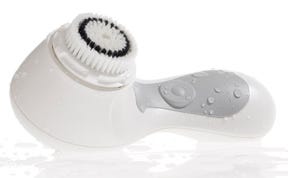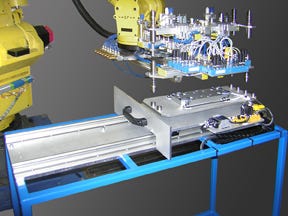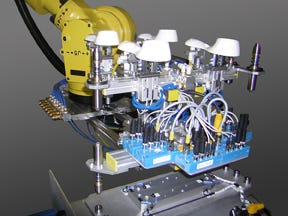Automation, tool tech keep
personal care product stateside
One way to avoid the difficulties of “reshoring” molding and moldmaking work from China is to keep the business onshore in the first place. For custom molder Cashmere, the answer has been smart automation and smarter design, including two-shot molding.
March 2, 2011
One way to avoid the difficulties of “reshoring” molding and 
moldmaking work from China is to keep the business onshore in the first place. For custom molder Cashmere, the answer has been 
smart automation and smarter design, including two-shot molding.
As market acceptance of the product grew and production consequently heated up, Cashmere Molding made a proposal to its OEM client Clarisonic: Invest in new tooling and automation to switch production from two presses and two two-cavity family molds—one requiring five hand-loaded inserts—to one two-shot injection molding machine running a four-cavity family tool that would have inserts placed robotically and produce finished parts.
Perhaps predictably, Clarisonic’s paraphrased response amounted to, “What’s in it for us?” Mike Gladwell, director of engineering at the Woodinville, WA custom injection molder, had a ready answer: estimated costs savings of at least 40% (ultimately the new setup doubled capacity and reduced labor costs by 70%), with a less-than-six-month return on the tooling investment.
|
Founded in 1991 with two employees, including current president and CEO Greg Herlin, Cashmere has championed intelligent process design, highlighting automation and advanced molding techniques to grow to more than 50 employees. Instead of reducing headcount as it has automated, the company has added 20 staff and, perhaps most impressively, has lured five customers back from China on the basis of Cashmere’s quality and cost competitiveness.
Tough project, 
able partners
For the Clarisonic project, the company worked with Wittmann Battenfeld for robotics, SAS Automation LLC for custom end-of-arm tooling (EOAT), The Turner Group for cell design, and Engel for injection technology. “Cashmere’s engineering came, pulled together those vendors and the customer, and coordinated the effort with everyone,” Gladwell says, “so it really was a team effort to get it all working.”
The product itself is the Clarisonic Pro-Handle powered facial cleaning device. Cashmere was molding the handle enclosure, including an overmolded elastomer grip and an indicator lens in the form of a light pipe that had to be inserted into the cavity prior to molding.
The light pipe proved a particular challenge given its small size, about as big as two BBs side by side, and the need for its precise placement. SAS was tasked with creating a customized EOAT that could insert two of the light pipes and work within a 2+2-cavity transfer mold that requires the EOAT to pick two inserts at once. The mold itself had only 0.0015-inch clearance on either side to fit the inserts, and since floor space was limited, the insert shuttle table and guarding needed to be as compact as possible.
When Cashmere started on the project, it created two sets of molds, running substrates on a 150-ton press, placing the parts in a box, and walking them to a second machine where a worker would manually insert them for overmolding. For the front part of the handle, two lights are inserted in its front, as well as three small brass pins that hold the brush in, a total of four hand-loaded inserts. A family mold, the tool also produced one handle’s back portion, which also had a light.
“That was all well and good,” Gladwell says, “but as volumes grew, the cost was high and the production was slow.” It was particularly hampered by operator error in the hand loading of inserts. “Even though you couldn’t technically put [the inserts] in backwards, we managed to get a couple of guys who did.”
At this point in time, the success of the product meant that Cashmere was running it on a 24/6 schedule, a “sweet spot” of volume that could allow for a more automated solution. Gladwell says, “Cashmere came to the table and told Clarisonic, ‘Hey, there’s a better way to do this. We’ve got this two-shot equipment; you should consider retooling and turning this system into a four-cavity family mold that will produce two completely finished parts.’”
Clarisonic approved the switch, and Cashmere moved forward with the new molding concept. For the three brass pins, it decided it would be best to handle those as a postmolding press-in insert. The biggest challenge remained the light pipes. One placed in each cavity was an orientation nightmare: They only had 0.0015-inch of wiggle room. If they skewed diagonally, light would not travel through the pipe. In conjunction with its moldmaker Premier Tool, and EOAT supplier SAS, Cashmere decided the best plan would be to include numerous locating features within the tool, with three to four in each cavity helping locate the end effector within the cavity.
SAS also supplied a sliding table, from which the light tubes would be picked up. The design was such that the robot and end effector could automatically tell where the light pipes were. “One of the big challenges was, ‘Man, how do we get an end effector to land within a thou [0.001 inch] vertically and horizontally in the press and come out and land on a table within the same thou and grab the parts to be installed, 24/6?’ That’s a lot of shots to keep everything perfect,” says Gladwell.
In between those shots, the Wittmann robot picks up two light pipes, drops them into the press, goes to the A side, installs them in the side of the tool, then goes over to the end effector on the B side of the tool to pick four parts—two complete products and two substrates ready for overmolding.
Beating China on price
At this time, the process is running 24/6, with good output of 99.6%, having done so since its initial startup. “Really, the first time it went in the press, it started up seamlessly,” Gladwell says. “It was the coordination between the toolmaker, and the molder, and the gripper people, with some support from Wittmann and The Turner Group that really made this thing work like a champ.”
The company has carried over the concept for other parts, building three more two-shot tools that use the exact same system. “It was super exciting for us, and it was super exciting for them,” Gladwell says. “They’re saving a ton of money, and they’ve got super-reliable production.”
The money savings are helping Cashmere compete at a time when many smaller shops are dropping out of the game. “We’re very proud that Cashmere found a way to not only compete with China, but also beat China on pricing,” Gladwell says. “In a large part, that’s thanks to Clarisonic making the investment and allowing us to purchase that equipment, having faith in a U.S. manufacturer. You know, I’m not waving the flag; that’s just cost savings and service, not patriotism.” —Tony Deligio
Cashmere Molding Inc.
 | www.cashmeremolding.com
Engel | www.engelglobal.com
SAS Automation LLC | www.sasgripper.com
The Turner Group | [email protected]
Wittmann Battenfeld | www.wittmann-ct.com
About the Author(s)
You May Also Like





